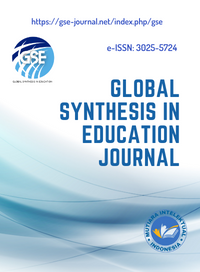The Influence of Clo3D Software on Sustainable Fashion Practices: A Comprehensive Literature Analysis
DOI:
https://doi.org/10.61667/jf3jxx34Keywords:
Clo3D software, Sustainable fashion, Practice fashion, Digital design, Resource managementAbstract
The fashion industry is increasingly turning to digitalization to address the pressing challenges of sustainability. This comprehensive literature analysis explores the influence of Clo3D software on sustainable fashion practices, focusing on its environmental, social, and economic impacts. Clo3D, a 3D garment visualization tool, has been adopted by designers and manufacturers to reduce waste, improve design efficiency, and enhance resource management. A systematic literature review examined studies highlighting the application of Clo3D in sustainable fashion initiatives. The results reveal that Clo3D significantly contributes to environmental sustainability by reducing fabric waste and enabling more precise production processes. Additionally, the software promotes social sustainability by fostering inclusivity and transparency in design and production workflows. From an economic standpoint, Clo3D aids in reducing costs and accelerating time-to-market for sustainable fashion products. However, challenges such as accessibility and the learning curve for new users remain barriers to its widespread adoption. This review underscores the transformative potential of digital tools like Clo3D in advancing sustainability within the fashion industry. It suggests avenues for future research to explore the integration of digital technologies in sustainable fashion practices further
References
Bertola, P., & Teunissen, J. (2018). Fashion 4.0. Innovating fashion industry through digital transformation. Research Journal of Textile and Apparel, 22(4), 352–369. https://doi.org/10.1108/RJTA-03-2018-0023
Buyukaslan, E., Jevsnik, S., & Kalaoglu, F. (2018). Comparative analysis of drape characteristics of actually and virtually draped fabrics. International Journal of Clothing Science and Technology, 30(3), 286–301. https://doi.org/10.1108/IJCST-06-2017-0085
Chi, Y.-M., & Han, X.-Y. (2024). Digital Gown Design Based on CLO3D. In Y. Li, S. K. An, & T. J. Li (Eds.), Textile Bioengineering and Informatics Symposium Proceedings, TBIS (Vols. 2024-August, pp. 443–450). Textile Bioengineering and Informatics Society. https://www.scopus.com/inward/record.uri?eid=2-s2.0-85209393400&partnerID=40&md5=4d946f233dc8692d5079c00fe278dc09
Cloughton, C. (2024). Creativity and Innovation in Fashion Forecasting. In Creativity and Innovation in the Fashion Business: Contemporary Issues in Fashion Design and Product Development (pp. 113–140). Taylor and Francis. https://doi.org/10.4324/9781003332749-5
Dana, L.-P., Boardman, R., Salamzadeh, A., Pereira, V., & Brandstrup, M. (2023). Fashion and environmental sustainability: Entrepreneurship, innovation and technology. In Fashion and Environmental Sustainability: Entrepreneurship, Innovation and Technology. De Gruyter. https://doi.org/10.1515/9783110795431
Davis, L. Y., Zhao, L., Davis, D., & Liu, Y. (2024). Identifying critical resources for successful fashion startups in the USA: an exploratory study. Journal of Fashion Marketing and Management, 28(5), 997–1014. https://doi.org/10.1108/JFMM-04-2023-0091
Demyen, S. (2024). The Online Shopping Experience During the Pandemic and After—A Turning Point for Sustainable Fashion Business Management? Journal of Theoretical and Applied Electronic Commerce Research, 19(4), 3632–3658. https://doi.org/10.3390/jtaer19040176
Fung, H.-K., To, C. K.-M., Leung, C.-S., & Zhang, Z. (2004). Innovation Process Management in Global Fashion Business: Modelling Iteration in Innovation Process Activities. Research Journal of Textile and Apparel, 8(1), 88–98. https://doi.org/10.1108/RJTA-08-01-2004-B010
Gabriel, M. B. (2023). The economics of exclusion: Why inclusion doesn’t fit fashion’s business model. In Pioneering New Perspectives in the Fashion Industry: Disruption, Diversity and Sustainable Innovation (pp. 93–104). Emerald Group Publishing Ltd. https://doi.org/10.1108/978-1-80382-345-420231008
Gurova, O., & Morozova, D. (2018). A critical approach to sustainable fashion: Practices of clothing designers in the Kallio neighborhood of Helsinki. Journal of Consumer Culture, 18(3), 397–413. https://doi.org/10.1177/1469540516668227
Huggard, E., & Särmäkari, N. (2023). How digital-only fashion brands are creating more participatory models of fashion co-design. Fashion, Style and Popular Culture, 10(4), 583–600. https://doi.org/10.1386/fspc_00176_1
Josyula, S., Sindhav, B., Eesley, D., & Redd, S. (2024). Fashion-Tech disruption: The Ft. you case study. In Driving Decentralization and Disruption With Digital Technologies (pp. 36–54). IGI Global. https://doi.org/10.4018/979-8-3693-3253-5.ch003
Lamoudan, H., Abenghal, L., Belosinschi, D., Brouillette, F., Dolez, P., Panneton, R., & Fonrouge, C. (2024). Sustainable Transformation of Cellulose-Containing Textile Waste into Multifunctional Panels with Tailored FR-Lignocellulosic Fibres. Polymers, 16(23). https://doi.org/10.3390/polym16233242
Leaño, M. J. (2005). The applications of textile digital printing. Eurostitch Magazine, 13(72), 14–17. https://www.scopus.com/inward/record.uri?eid=2-s2.0-14844339424&partnerID=40&md5=27e4a6915f571f19bc42b25b49863881
Liu, Z.-C., Cao, K., Li, T. J., & Li, Y. (2022). Digitalizing Fashion Business Through Fashion Big Data (FBD) Platform. Textile Bioengineering and Informatics Symposium Proceedings, TBIS, 186–196. https://www.scopus.com/inward/record.uri?eid=2-s2.0-85141424044&partnerID=40&md5=1dbd9536a219c638788349a58d34eeb0
Niinimäki, K., Peters, G., Dahlbo, H., Perry, P., Rissanen, T., & Gwilt, A. (2020). The environmental price of fast fashion. Nature Reviews Earth and Environment, 1(4), 189–200. https://doi.org/10.1038/s43017-020-0039-9
Nilmini Bhagya, K. P., Medagedara Karunaratne, P. V, Ranathunga, G. M., & Ranaweera, A. (2025). Fashion niche market strategies: a systematic literature review. Journal of Fashion Marketing and Management, 29(1), 137–163. https://doi.org/10.1108/JFMM-06-2024-0228
Page, M. J., McKenzie, J. E., Bossuyt, P. M., Boutron, I., Hoffmann, T. C., Mulrow, C. D., Shamseer, L., Tetzlaff, J. M., Akl, E. A., Brennan, S. E., Chou, R., Glanville, J., Grimshaw, J. M., Hróbjartsson, A., Lalu, M. M., Li, T., Loder, E. W., Mayo-Wilson, E., McDonald, S., … Moher, D. (2021). The PRISMA 2020 statement: An updated guideline for reporting systematic reviews. In The BMJ (Vol. 372). BMJ Publishing Group. https://doi.org/10.1136/bmj.n71
Pelikánová, R. M. G., Nĕmečková, T., & MacGregor, R. K. (2021). CSR statements in international and czech luxury fashion industry at the onset and during the COVID-19 pandemic-slowing down the fast fashion business? Sustainability (Switzerland), 13(7). https://doi.org/10.3390/su13073715
Pranta, A. D., Tareque Rahaman, M., Reazuddin Repon, M., & Shikder, A. A. R. (2024). Environmentally sustainable apparel merchandising of recycled cotton-polyester blended garments: Analysis of consumer preferences and purchasing behaviors. Journal of Open Innovation: Technology, Market, and Complexity, 10(3). https://doi.org/10.1016/j.joitmc.2024.100357
Resca, A., & D’Atri, A. (2008). Reconfiguring the fashion business: The YOOX virtual boutique case study. In Interdisciplinary Aspects of Information Systems Studies: The Italian Association for Information Systems (pp. 155–161). Physica-Verlag HD. https://doi.org/10.1007/978-3-7908-2010-2_20
Sayem, A. S. M. (2023). Digital Fashion Innovations: Advances in Design, Simulation, and Industry. In Digital Fashion Innovations: Advances in Design, Simulation, and Industry. CRC Press. https://doi.org/10.1201/9781003264958
Sayem, A. S. M., Ahmed, F., Julhazz, M. R., Islam, M., & Kader, M. S. (2024). Virtual fashion in Metaverse. In Human-Centered Metaverse: Concepts, Methods, and Applications (pp. 141–152). Elsevier. https://doi.org/10.1016/B978-0-443-21996-2.00014-0
Sharma, D., Sampath Kumar, J. P., & Shylaja, K. R. (2025). The Future of Artificial Intelligence in Fashion: Innovations, Challenges, and Implications. In P. Nanda, S. Srivastava, V. K. Verma, & P. Vyas (Eds.), Smart Innovation, Systems and Technologies (Vol. 398, pp. 493–509). Springer Science and Business Media Deutschland GmbH. https://doi.org/10.1007/978-981-97-5200-3_35
Sumo, P. D., Ji, X., & Cai, L. (2022). SWOT Framework Based on Fuzzy Logic, AHP, and Fuzzy TOPSIS for Sustainable Retail Second-hand Clothing in Liberia. Fibres and Textiles in Eastern Europe, 30(6), 27–44. https://doi.org/10.2478/ftee-2022-0050
Sun, X., & Ha-Brookshire, J. E. (2025). Drivers and Enablers of Digital Readiness in the Fashion Industry: A Systematic Literature Review. Clothing and Textiles Research Journal. https://doi.org/10.1177/0887302X241311027
Táborecká, J., Rajic, T., Turčínková, J., Sedej, T., & Ozeliene, D. (2025). ENVIRONMENTAL CONCERNS VS. SUSTAINABLE CLOTHES PURCHASES AMONG VARIOUS GENERATIONS OF FEMALES IN CEE COUNTRIES. Economics and Sociology, 18(1), 116–131. https://doi.org/10.14254/2071-789X.2025/18-1/6
Thorisdottir, T. S., Johannsdottir, L., Pedersen, E. R. G., & Niinimäki, K. (2024). Social, environmental, and economic value in sustainable fashion business models. Journal of Cleaner Production, 442. https://doi.org/10.1016/j.jclepro.2024.141091
Wang, M., Murphy, R., & Christie, I. (2025). Bringing Sustainable Practices, Fashion Shows, and Sociological Insights Together to Reinvigorate Sustainable Fashion Education. Sustainability (Switzerland), 17(2). https://doi.org/10.3390/su17020631
Yu, Q., & Zhu, G. (2024). Virtual Simulation Design of Mazu Clothing Based on Digital Technology. Fibers and Polymers, 25(7), 2773–2787. https://doi.org/10.1007/s12221-024-00566-9
Downloads
Published
Issue
Section
License
Copyright (c) 2025 Global Synthesis in Education Journal

This work is licensed under a Creative Commons Attribution-NonCommercial-ShareAlike 4.0 International License.




















